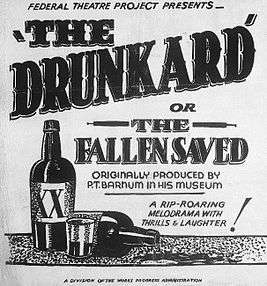The Drunkard

The Drunkard; or, The Fallen Saved is an American temperance play first performed in 1844.[1] A drama in five acts, it was perhaps the most popular play produced in the United States before the dramatization of Uncle Tom's Cabin [2] in the 1850s. In New York City, P.T. Barnum presented it at his American Museum in a run of over 100 performances.[3] It was among the first of the American temperance plays, and remained the most popular of them until it was eclipsed in 1858 by T. S. Arthur's Ten Nights in a Bar-Room.[2]
The primary writer of the play was William H. Smith, who also directed and starred in the original production in Boston in the 1844–45 season.[1][2] Smith was the stage manager at Moses Kimball's Boston Museum, where the play was originally produced.[2] An anonymous collaborator, believed to have been Unitarian minister John Pierpont, co-wrote the script.[2]
The play ran for an unprecedented 140 performances in the Boston Museums' 1844-45 season, sometimes running three times a day. This was astonishing at the time. The success of the play led to the beginning of the Temperance Movement's success.
In the 20th century
A production of The Drunkard opened at the Theatre Mart in Los Angeles in 1933 and ran for 36 years. At one point, Boris Karloff suggested adding an olio, a musical number following the performance, played in front of a olio drop.[4]
The dated melodrama of Smith's play made it a target of parody in films. In 1934, a production of The Drunkard was featured to comic effect in the W. C. Fields film The Old Fashioned Way.[5] The following year, James Murray and Clara Kimball Young starred in a film called The Drunkard, a comedy-drama in which two theatrical producers present the play as a farce with their needy relatives in the cast.[6][7] In 1940, Buster Keaton starred in another film parody, The Villain Still Pursued Her.[8]
A musical adaptation of the play by the British writer Brian J. Burton, The Drunkard or Down With the Demon Drink, was published in 1968 and has been performed several times since.[9][10]
Another version of the play, adapted by Richard Mansfield Dickinson, has been performed every Saturday night beginning on November 14, 1953[11] at the Tulsa Spotlight Theatre, located in Tulsa, Oklahoma; the company claims that this is the longest-running stage production in America.[12][13]
Plot
The Drunkard, or the Fallen Saved, follows Edward Middleton, a fine upstanding citizen, who has just received ownership of a large estate. In the opening scene of the play we find Mrs. Wilson, and Mary Wilson talking about how they have been living on the estate under the care of the pervious owner, and their fear of what the new owner will do with them. Lawyer Cribbs then makes his first appearance, explaining how the new owner will probably kick them off of the land. However, when Edward finally arrives, he instead falls immediately in love with Mary. Time passes, and we see the Middleton family expanded by one: Edward and Marys' daughter, Julia. The Lawyer Cribbs has a plan to destroy Edward and take all of his money however, and after a long night at a local bar, Cribbs springs his plan into action. Cribbs, knowing that Edward enjoys the occasional drink, uses this against him, and turns him into a mad drunk. After getting Edward to sign all of his money away, Cribbs leaves Edward to ruin. Edward leaves his family, and moves away to New York, and lives on the streets, as a drunk. His family tries to follow him, but end up living in destitution as well. A family friend, William Downton finds Mary and Julia, and promises to help find Edward. During this time, Edward is approached by Mr. Renclaw, a recovered alcoholic himself, who takes Edward into his care for rehab. Eventually the family is reunited after Edward becomes sober and is found by William. Lawyer Cribbs, however, is still on the loose, but with the help of a small boy, Cribbs is thwarted in his plan and arrested.
Characters and 1844 cast

|
|
See also
- American Temperance Society
- Boston Museum
- Federal Theatre Project
- Olio (musical number)
- P. T. Barnum
- Riverside Studio
References
Notes
- 1 2 "The Drunkard: Author's preface (1850 edition) in Uncle Tom's Cabin & American Culture: A Multi-media Archive on the University of Virginia website
- 1 2 3 4 5 "The Drunkard" in Uncle Tom's Cabin & American Culture: A Multi-media Archive on the University of Virginia website
- ↑ Burrows, Edwin G. & Wallace, Mike (1999), Gotham: A History of New York City to 1898, New York: Oxford University Press, ISBN 0-195-11634-8 p.815
- ↑ Counter, B. "The Drunkard at Theatre Mart" on the Los Angeles Theatres website
- ↑ The Old Fashioned Way at the Internet Movie Database
- ↑ Box Office, June 8, 1935: p. 29 seen at issuu.com
- ↑ The Drunkard (1935) at the Internet Movie Database
- ↑ Mitchell, C. (2004). Filmography of Social Issues: A Reference Guide. Greenwood Press. ISBN 0-313-32037-3. p. 4.
- ↑ "Brian J. Burton" on doolee.com
- ↑ The Drunkard, Music Theatre International, accessed July 31, 2013
- ↑ http://spotlighttheater.org/AboutUs.htm
- ↑ "History of the building" on the Tulsa Spotlight Theatre website
- ↑ Regan Henson, "In On The Act", Oklahoma Magazine, January 2012.